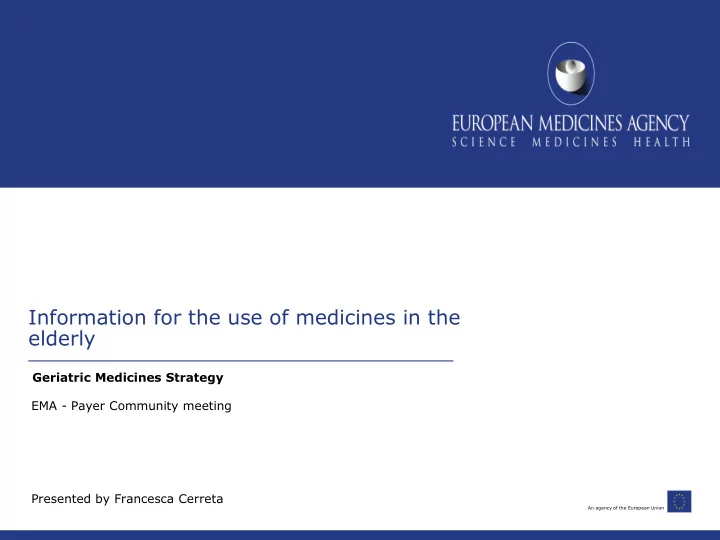

Information for the use of medicines in the elderly Geriatric Medicines Strategy EMA - Payer Community meeting Presented by Francesca Cerreta An agency of the European Union
Population pyramid, EU-28, 2016 and 2080 (% of total population, Men , Women) EMA Geriatric Medicines Strategy (2011): Evidence based Medicines used by geriatric patients must be of high quality, and appropriately medicine researched and evaluated… for use in this population . Improve the availability of Informed information on the use of prescription medicines for older people. 2
Study on off-label use of medicinal products in the EU (European Commission, 2017) …”The efficacy and safety of medicines are hardly investigated in elder, multimorbid patients. The lack of clinical data obtained in elderly is (still) a matter of concern. Elderly form a grey area. One could argue that medicinal products authorized for adults and used in the elderly is in principle not off-label unless the SmPC mentions: • upper age ranges • special warnings • other restrictions for use in the elderly” 3 EMA - Payer Community meeting
CHMP D80 AR Pilot - Elderly population Clinical Trials Regulation (EU No 536/2014): “justification for the age allocation of subjects if a specific age group is excluded from or underrepresented in the CTs”. ICH E7: Studies in Support of Special Populations: Geriatrics “population in the clinical development program is representative of the target • patient population; in the MAA data should be presented for various age groups (i.e. <65, • 65-74, 75- 84 and ≥85) to assess the consistency of the treatment effect and safety profile”. CHMP initiated a pilot on 10 new Marketing Authorisations Additional geriatric section to the ARs templates. Day 80 and Day 210 EPAR SmPC PIL
Information required for the EPAR Adequate data is eCTD Module Age 65-74 Age 75-84 Age 85+ number / total number (all number / total number (all ages) number / total number ages) (all ages) available for age range? Efficacy and Safety Studies Frail patients included? Human PK Studies Epidemiology CT inclusion/exclusion criteria Age <65 Age 65-74 Age 75-84 Age 85+ MedDRA Terms number number number number (percentage) (percentage) (percentage) (percentage) Co-morbidities Total ADRs Concomitant medication Serious ADRs – Total - Fatal - Hospitalization/prolong existing hospitalization Safety signals - Life-threatening particularly relevant? - Disability/incapacity - Other (medically significant) (e.g. dizziness, delirium, AE leading to drop-out orthostatic effects, falls, Psychiatric disorders sedation, bleeding, urinary Nervous system disorders retention, loss of appetite). Accidents and injuries Cardiac disorders Appropriately grouped? Vascular disorders dizziness + falls + fractures + syncope Cerebrovascular disorders Infections and infestations reviewed together. Quality of life decreased Sum of postural hypotension, Anticholinergic effects? falls, black outs, syncope, 5 dizziness, ataxia, fractures
What is the most frequent situation? Geriatric population is the largest users of medicines, but … Data are usually missing in patients over 75 and/or with comorbidities and co-medications. The lack of data over a certain age is usually stated in 4.2 Posology . Reflection paper on the wording of therapeutic indication Benefit-risk balance not established. Extrapolation possible? ? Age limits in 4.1 indication ? (not in 4.2) Warning in 4.4 ? Specific sub-sections for the older patients in 4.8, 5.1? 6 EMA - Payer Community meeting
Analysis of SmPC wording on Meaningful SmPC guideline recommendation older patients for payers? 4.1 Indication Very rarely specified It should be stated in which age groups the product (generic“adults” includes elderly) is indicated, specifying age limits Not restricted indication 4.2 Posology The safety and efficacy have not been established Sometimes, a) no data are available (with age limits >65, 75, 85) b) limited data are available Other commonly used: It should not be used because of efficacy or safety - the use is not recommended concerns. - should be initiated with caution 4.3. Contraindications a) Safety data give rise to concerns b) Elderly patients have been excluded from Very rarely studies on grounds of safety 4.4 Warnings 7 Patients populations not studied in clinical trials Rarely
Meaningful for payers? SmPC guideline recommendation 4.1 Indication Very rarely specified Age limits should be explicit -> defining target population It should be stated in which age groups important for economic analysis the product is indicated, specifying age otherwise we pay for uncertainty limits ..but: troublesome not to reimburse 4.2 Posology Sometimes (with age limits >65, 75, 85). Other wordings. • Age limits should be in 4.1. The safety and efficacy have not been • CLEAR INFORMATION FOR PHYSICIANS: established limited/no data, not established safety/efficacy. a) no data are available b) limited data are available • Dose adjustment important for economic analysis -> PK/PD needed • “caution” is meaningless, uniform wording needed. It should not be used because of efficacy • “not recommended” less strict than “should not be used”, or safety concerns. should be in 4.3 contraindication if safety concern. 8
Meaningful for payers? SmPC guideline recommendation 4.3. Contraindications Very rarely Off-label? a) Safety data give rise to concerns If excluded from studies, for whatever reason, it should be CLEAR b) Elderly patients have been excluded from studies on grounds of safety important for physicians’ proper treatment decision 4.4 Warnings Rarely Off –label? If not studied it should be stated CLEAR Patients populations not studied in clinical trials + JUSTIFICATION of why POSITIVE BENEFIT/RISK balance is ASSUMED 9 EMA - Payer Community meeting
Recommend
More recommend